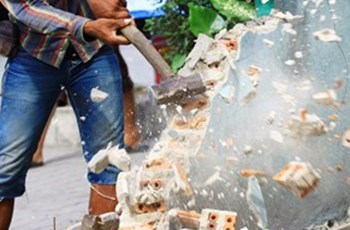
Over the past year there has been a plethora of news stories about lead exposure. From Flint, Michigan to Portland, Oregon, details have emerged about schools, homes, water supplies, and other areas and structures contaminated by lead. It hardly surprises me when these pop up in the news, as lead has been used generously in piping, paint, gasoline, ammunition, and batteries, among many other products during the last century.
A recent story about demolition of old buildings and houses leading to lead exposure caught my attention, as I had never considered this as a source of exposure even after years of researching lead. [1] The number of demolitions in the Pacific Northwest has shot up rapidly, and with it, concerns from neighbors about lead dust exposure and lax demolition regulations.
The Source of the Problem - Lead in Paint
Lead was added to paint up until 1977 when it was eventually banned because children were being poisoned from consumption of paint chips. Lead’s ability to increase paint durability, resist moisture, speed up drying, and retain a “new” look were the primary reasons for its addition to paint. In the early 1900s up to 70% of the pigments contained in paint were lead-based, with a single paint can weighing nearly 15 pounds. This resulted in hundreds of pounds of lead being painted in multiple coats across walls, windowsills, and other parts of homes built before 1978. This has become a major problem for most cities in the United States, as a vast majority of houses built prior to 1978 are coated in lead and are deteriorating.
Precautions to Reduce Lead Dust during Demolitions
New research is revealing the dangers of lead exposure at levels far lower than was once thought safe, especially for children. |
The current demolition regulations have a lead “loophole” in which there is no requirement to trap lead dust. Remodel and repair jobs, on the other hand, have strict regulations that require safety precautions to be taken to prevent spreading of lead dust and paint debris. Some companies have taken it upon themselves to prevent neighborhood lead exposure during demolition by removing doors, windows, and railings coated in lead paint prior to demolition, and/or by applying water to knock down dust, demolishing on a rainy day, or working during times where there is little wind. It has been shown that lead dust from demolition can travel up to 400ft if the conditions are right. [2] Lead dust can deposit on surrounding soil, homes, sidewalks, and playgrounds, resulting in inhalation by humans, especially on hot and dry summer days. [3] [4]
In many cases, soil around demolition sites becomes unsafe due to lead contamination and has to be replaced with new topsoil. [5] Lead dust can be tracked inside houses where it deposits on the floor and remains a serious health risk for toddlers and animals. [6] Studies have shown increased blood lead levels in children that live around demolition activity, including one completed in New York that linked 14% of all elevated blood lead levels in children to demolition and renovation projects. [7] [8] [9]
Help is on the Way
Lead is a bio-accumulating neurotoxin, with no safe exposure level. New research is revealing the dangers of lead exposure at levels far lower than was once thought safe, especially for children. Lawmakers are currently working to fix the lead demolition “loophole,” which will hopefully create new regulations and restrictions for home demolitions to protect humans and animals. Precautionary steps can be taken to prevent lead dust exposure, such as leaving shoes at the door, washing hands, wiping down surfaces with a wet towel or mop, and preventing unnecessary contact with soil. [10]
If you are concerned about whether or not you or your family has been exposed to lead, ZRT Laboratory offers a simple at-home finger prick blood spot test that accurately measures lead, along with mercury, cadmium, selenium, zinc, copper and magnesium. For extra information on childhood lead exposure, please read our recent blogs on how blood lead results can be misleading and 10 need-to-know facts about lead.
More about Elements Testing
- Blog: 10 Need-to-Know Facts About Lead Exposure
- Download: Heavy Metals & Essential Elements Provider Data Sheet
- Download: Heavy Metals & Essential Elements Testing Patient Handout
References
[1] http://www.portlandmercury.com/news/2016/09/28/18593355/no-ones-policing-lead-dust-in-demolition-happy-portland?mc_cid=51c23aed36&mc_eid=344742dd5c
[2] Jacobs DE, Cali S, Welch A, Catalin B, Dixon SL, Evens A, Mucha AP, Vahl N, Erdal S, Bartlett J. Lead and other heavy metals in dust fall from single-family housing demolition. Public Health Rep. 2013 Nov-Dec;128(6):454-62.
[3] Lanphear BP, Roghmann KJ. Pathways of lead exposure in urban children. Environ Res. 1997;74(1):67-73.
[4] Laidlaw MA, Filippelli GM, Sadler RC, Gonzales CR, Ball AS, Mielke HW. Children's Blood Lead Seasonality in Flint, Michigan (USA), and Soil-Sourced Lead Hazard Risks. Int J Environ Res Public Health. 2016 Mar 25;13(4):358. doi: 10.3390/ijerph13040358.
[5] Clark S, Menrath W, Chen M, Succop P, Bornschein R, Galke W, Wilson J. The influence of exterior dust and soil lead on interior dust lead levels in housing that had undergone lead-based paint hazard control. J Occup Environ Hyg. 2004 May;1(5):273-82.
[6] Caravanos J, Weiss AL, Blaise MJ, Jaeger RJ. A survey of spatially distributed exterior dust lead loadings in New York City. Environ Res. 2006 Feb;100(2):165-72. Epub 2005 Jul 11.
[7] Farfel MR, Orlova AO, Lees PS, Rohde C, Ashley PJ, Chisolm JJ Jr. A study of urban housing demolitions as sources of lead in ambient dust: demolition practices and exterior dust fall. Environ Health Perspect. 2003 Jul;111(9):1228-34.
[8] Rabito FA, Iqbal S, Shorter CF, Osman P, Philips PE, Langlois E, White LE. The association between demolition activity and children's blood lead levels. Environ Res. 2007 Mar;103(3):345-51. Epub 2006 Nov 30.
[9] CDC (Centers for Disease Control and Prevention) 2009. Children with elevated blood lead levels related to home renovation, repair, and painting activities—New York State, 2006–2007. MMWR Morb Mortal Wkly Rep 58(3):55–58.
[10] http://www.cdc.gov/nceh/lead/tips.htm
